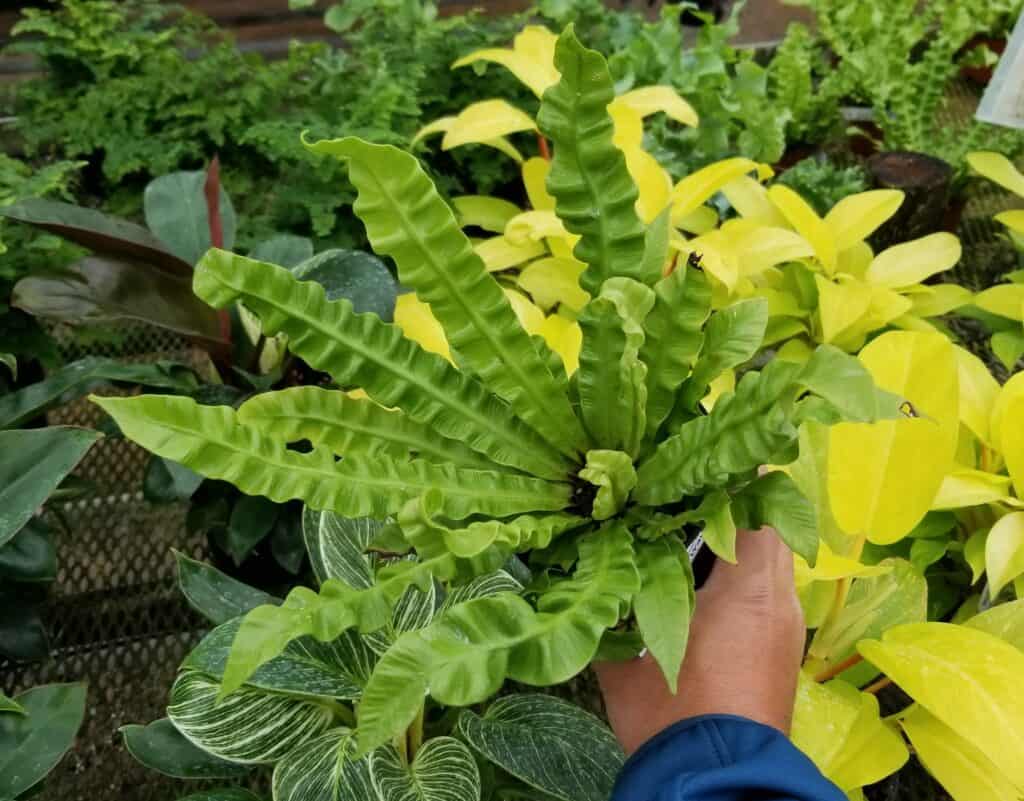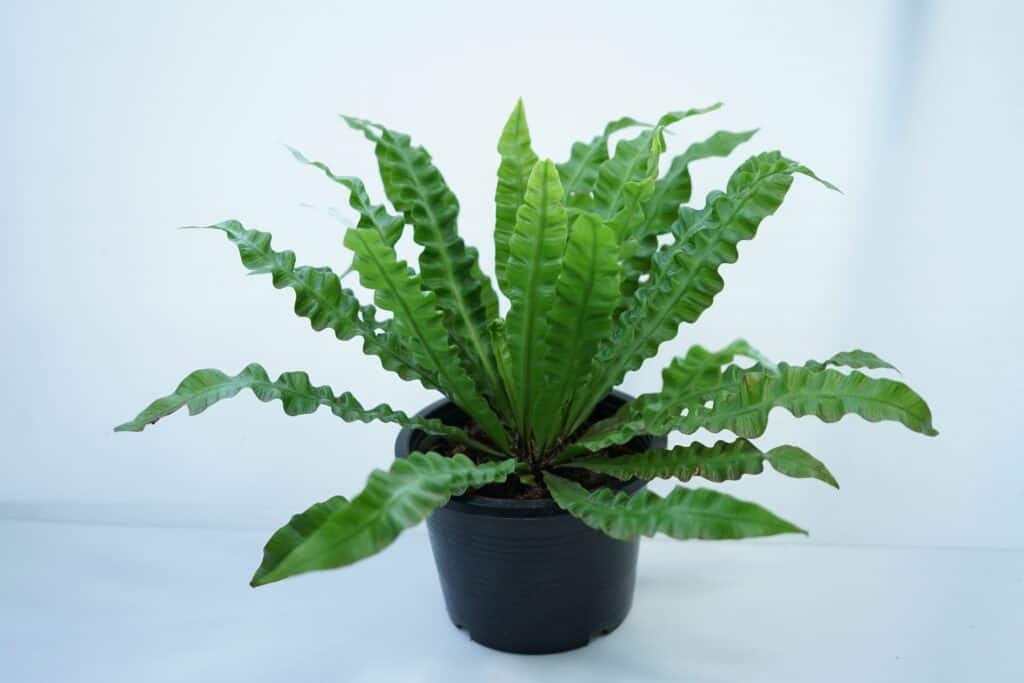The crispy wave fern is a cultivar of the larger bird’s nest fern. They are both native to tropical jungles and thrive as epiphytes. Epiphytes are organisms that grow on the surface of another plant. These ferns grow on palm trees and collect water and organic matter in their central leaf rosette. They can also be grown as terrestrial plants (on land) as long as the humidity and moisture conditions are perfect.
The crispy wave fern and bird’s nest fern look very similar. I have them both in my house; when placed side by side, they can barely be told apart. The most significant difference is at the edge of the long leaves or fronds. One is wavy, and one is smooth. There are also a few other minor differences which we will discuss in more detail below.
Comparing Crispy Wave Fern vs. Bird’s Nest Fern

The crispy wave fern has long, thin fronds with ruffled edges.
©Sheila Shu Cheung/Shutterstock.com
| Crispy wave fern | Bird’s Nest Fern | |
|---|---|---|
| Scientific Family | Asplenium nidus | Asplenium |
| Fronds | Long and strap-like with curly or wavy edges (looks like an uncooked lasagna noodle) | Long and strap-like fronds with a silky, smooth appearance. Not wavy or curly along the edges |
| Growth Pattern | Stiff fronds that grow upright from a central rosette. More dense and bushy. | Stiff fronds that grow from a central rosette. Less dense and bushy. |
| Origins | Tropical southeast Asia, eastern Australia, Hawaii, Polynesia, Christmas Island, India, and east Africa | Tropical southeast Asia, eastern Australia, Hawaii, Polynesia, Christmas Island, India, and east Africa |
| Size | 12-18 inches tall and wide | 18-24 inches tall and wide |
| Growing Requirements | Moderate indirect sunlight. Evenly moist soil. 50% humidity or more. | Moderate indirect sunlight. Evenly moist soil. 50% humidity or more. |
| Toxicity | Non-toxic to humans and pets | Non-toxic to humans and pets |
Key Differences Between Crispy Wave Fern vs. Bird’s Nest Fern
The key difference between the crispy wave fern and the bird’s nest fern is that the crispy wave fern is a cultivar of a bird’s nest fern. They both have stiff fronds that grow from a central rosette. The crispy wave fern has curled or wavy leaf edges, while the bird’s nest fern does not.
We will go over a few more differences in more detail below.
Crispy Wave Fern vs. Bird’s Nest Fern: Leaf Description

The bird’s nest fern has long, narrow fronds with smooth, unbroken edges.
©Phuttharak/Shutterstock.com
The only way to tell the two ferns apart with the naked eye is by examining the edges of the leaves. The crispy wave fern has long, thin fronds with ruffled edges. The bird’s nest fern has long, narrow fronds with smooth, unbroken edges.
Crispy Wave Fern vs. Bird’s Nest Fern: Growth Pattern and Size

The crispy wave fern has a tighter growth pattern; its fronds grow from a central rosette.
©Khairil Azhar Junos/Shutterstock.com
Another difference is the size and pattern of growth. The crispy wave fern grows to a maximum height and width of 18 inches, while the bird’s nest fern is 24 inches tall and wide.
The crispy wave fern has a tighter growth pattern, its fronds grow from a central rosette in the same way as a bird’s nest fern, but they stay more upright, dense, and bushy. So side by side, the bird’s nest fern looks less dense, and the fronds splay outward and are less erect.
Crispy Wave Fern vs. Bird’s Nest Fern: Growing Requirements

Ferns prefer a snug pot. Being in a tight pot will encourage the plant to produce offspring.
©DragonWen/Shutterstock.com
In many countries, both of these types of ferns are houseplants. If you live in very temperate regions with no winter frost, you can grow either of them outside in the dappled shade. They both require identical care and love a warm, humid environment similar to the tropical jungles they call home. They need 50% humidity or more, indirect light, and a soil medium with plenty of peat, fir bark, or coconut coir. You will have a very happy fern if you can meet these conditions.
Ferns prefer a snug pot. Being in a tight pot will encourage the plant to produce offspring, so don’t be too hasty to transplant. If you wait and don’t transplant until the fern has produced one to three small ferns at the outside edges of the pot, you can have free ferns for life. Separate the young ferns from the parent and transplant them into pots that are only two inches larger than the previous one.
Crispy Wave Fern vs. Bird’s Nest Fern: Toxicity

In Taiwan, these ferns are considered culinary vegetables.
©LADDAWAN photo/Shutterstock.com
Neither the crispy wave fern nor the bird’s nest fern is toxic to humans or pets. In fact, in Tawain, these ferns are considered culinary vegetables. The young, tender sprouts of A. nidus are cut into small pieces and fried with garlic and chili peppers.
Rest assured that your pets and children will be safe, whether you are planting these ferns in the house or outside in the garden or greenhouse.
NEXT UP…
- Kimberly Queen Fern vs Boston Fern: What’s the Difference?
- 6 Ferns that Grow in Texas
- Foxtail Fern vs Asparagus Fern: What’s the Difference?
The photo featured at the top of this post is ©
Thank you for reading! Have some feedback for us? Contact the AZ Animals editorial team.






